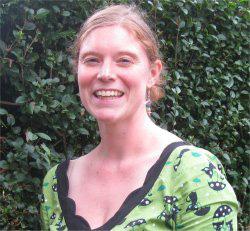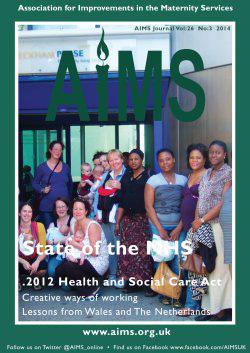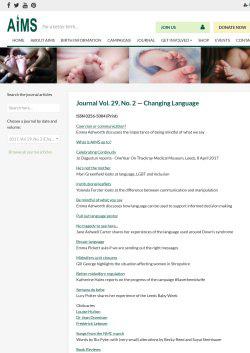
11 minute read
AIMS during the 2010s
from AIMS Journal, Vol 32 No 3 AIMS at 60 Making a difference past and future
by AIMS (Association for Improvements in the Maternity Services)
by Virginia Hatton, AIMS Trustee
The 2010s is the decade in which my two children were born and when I became a member of AIMS. Maternity care in the UK, and AIMS, have both gone through significant transitions in this decade. The AIMS Journal is now published online as an open access resource available to all. The Journal has featured discussions on the many opportunities that we as AIMS members have had in improving maternity services in this decade including the Better Births Report (2016), the national agenda to offer Continuity of Carer, the change from Maternity Services Liaison Committees (MSLCs) to Maternity Voices Partnerships (MVPs) and the challenges faced by independent midwives regarding insurance cover. However, there are articles on three topics that I feel best represent the current landscape of maternity care and why we need to improve it, and the changes that AIMS itself is undergoing in order to be a charity that supports ‘all maternity service users to navigate the system as it exists, and campaign for a system which truly meets the needs of all’1. I would encourage all readers of the AIMS Journal to read (or reread) these articles and reflect on their significance in your own birth work or lives, and most importantly to then take action.
Advertisement


Anything but Simple, by Jo Murphy-Lawless, 2014 When the Health and Social Care Act of 2012 was passed, some birth activists saw this as the end of effective national campaigning, as now there was no one accountable at the national level for national targets such as increasing the number of midwives. Other birth activists were more optimistic, seeing the advantages for local campaigning, for example getting a Continuity of Carer scheme running in one local area could be more achievable than guaranteeing Continuity of Carer nationally for all women. Jo Murphy-Lawless’ article on the impact of the Health and Social Care Act foreshadowed the challenges faced by One to One Midwives and Neighbourhood Midwives. Both of these names will be familiar to women who sought Continuity of Carer in the 2010s, and to midwives who wanted to offer this type of women-centred care. Unfortunately, the process of contracting to Clinical Commissioning Groups (CCGs) did not allow these models of care to be sustainable. Another example of outstanding care for women highlighted in this article was the Halcyon Birth Centre, which is also now closed. The coronavirus pandemic has demonstrated the consequences of underfunding and fragmentation that are results of privatisation, and this in many ways mirrors the impact of privatisation on maternity services2. I would encourage all AIMS members to seek to understand the continuing impact of privatisation of health and social care in their local area3 .
I found the following quotes from Jo Murphy-Lawless’ article useful for thinking about what AIMS’ role is amidst this change to our health care system, and what our role will be as campaigners in the future:
“We believe that there is incontrovertible evidence that midwives do not wish to work as they are having to do at present. We also strongly believe that the English public, and the people of Northern Ireland, Scotland and Wales wish to have an NHS that is truly public, publicly accountable, freed from the vice-like grip of market profit-taking as if it were a commodity like mobile telephones or computers. We need a social, holistic, approach throughout the NHS and certainly in maternity care.” “Independent Midwives and some of the new midwifery initiatives are providing the kind of maternity care that AIMS and other organisations have long campaigned for, but only a tiny minority of women can afford or have access to these, and only a tiny number of women will freebirth – another option about which women ask AIMS. AIMS’ position has been to support a woman’s plans, and that all women have the right to good maternity care and to be supported in their decisions about where, how and with whom to give birth irrespective of their economic situation. Thus, it has always responded to the growing tensions in maternity services by focusing first and foremost on the woman seeking support and has been endeavouring to work with the tensions forced upon us.” “Any activism will necessarily need to continue to challenge vigorously the increasing and debilitating focus on risk and fear which is driving the centralisation of birth into large obstetric units, the medicalisation of birth, and the ‘expert’ culture where women’s decisions are overridden, all of which plays into the now wholesale privatisation of the NHS.”
He’s Not the Mother, by Mari Greenfield, 2017 The second article I would urge all AIMS readers to be familiar with was the first AIMS article to address the challenges faced by trans men who give birth. This article (linked above), and a following one, Birth Beyond the Binary by AJ Silver (2019), challenged AIMS as an organisation to be inclusive and supportive of all maternity service users. The changes to the language in AIMS books, including the term ‘birthing women and people’ and the first AIMS Equality, Diversity and Inclusivity Statement4 have their roots in the discussions that came out of these articles. These discussions were not easy ones, and the quotes below highlight why this was a challenge within AIMS, as well as the better practices that AIMS is trying to implement itself within the charity to be inclusive.
In ‘He’s Not the Mother’, Mari Greenfield says:
“MacDonald (2015)5,urges those involved in maternity care not to choose between celebrating women, and ensuring we include all pregnant people. He advocates being ‘generous with our ink’ and ensuring we include everyone. In the context of LGBT inclusive language, we could add the suggestion to those involved in maternity care to be ‘generous with our questions’ – starting with a generous approach to questioning our own assumptions.”
In ‘Birth Beyond the Binary’, AJ Silver says:
“Pleas for inclusion are often met with the objection that it is erasing the overwhelming majority of those who birth, the mothers, the women. This thought process needs some examining here.
The example I always fall back on is that ramps on public buildings take nothing away from the able bodied people that want to access them, but it makes it possible for disabled persons to access them. Cis-heteronormativity will not disappear overnight because we include language, tick boxes and space in our hearts and minds to accept that not all who birth are women or mothers.”
Diverse, Not Defective, by Beth Whitehead, 2019 The last article that I would like to draw attention to from the 2010s was written in response to the MBRRACE report (2018)6 , which highlighted that black women were five times and Asian women twice as likely as white women to die in pregnancy and childbirth in the UK. Campaigning against privatisation of the health services (as mentioned above in ‘Anything But Simple’) is out of AIMS’ remit as a small maternity services charity. However, maternal mortality is something which we as a charity and individual activists must be shouting about. There can be no ‘improvement’ more vital in the maternity services than preventing women’s deaths. Black Lives Matter has highlighted the everyday acts of racism prevalent throughout all aspects of our lives, and why it is more important than ever for this to be a central focus of all of those working to improve the maternity services.
Beth Whitehead is quick to point out that more obstetric intervention may not be the way to prevent these unnecessary deaths:
“BAME (ed: Black, Asian and Minority Ethnic) women can be subjected to more interventions because of the institutional criteria and protocols limiting their choice of place of birth. They are often subjected to birthing in the obstetric units, interventions and cascading effects because their bodies are different to the Western ‘norm’ and so considered to be less able and defective. If more interventions actually lead to improved safety, you would expect mortality rates to be lower for
BAMEs as they are more subjected to protocol interventions and yet the [MBRRACE] report shows that this is not the case.
Something is not adding up.” The article also outlines how we need to question our own assumptions, understand and challenge institutional racism and see how continuity of carer is a positive solution:
“When discussing the poorer maternity outcomes for BAME women, I notice people often fall back on the stereotypical narratives of vulnerability due to lack of language skills and low socioeconomic status. However, these assumptions are outdated. Most British-born BAME women speak English as a first language and many who are immigrants to the UK speak English even in their countries of origin. The MBRRACE report table 2.9 outlined that out of all the women who died, 96% spoke English and 63% were actually born in the UK. Just look around your workplace, commuter trains, hospitals, cafes and restaurants, there are BAME women working everywhere in a range of professions and are of various socioeconomic status. What is going on? A woman’s chance of survival, how she is treated in pregnancy and childbirth and her autonomy should not be determined by the colour of the skin she was born with or the ethnic community she came from. It’s time for healthcare providers to see past the colour of someone’s skin and acknowledge the effects of structural inequality in the healthcare system, their attitude and practices. We are unique individuals deserving of personalised, respectful and safe [health]care. Most importantly, we need to stop racist narratives about women’s bodies; stop presenting ‘white, British women’ as the default to which we should all be compared …, the average [from] which we are considered to deviate and start talking about diversity. After all, diversity is what helps humanity survive and thrive. Continuity of Carer, a relationship-based model, will help to mitigate [legal risks] because client knowledge and a relationship with the pregnant woman will minimise mistakes and improve birth experience. It will also give BAME women a better chance of being listened to, treated with respect and provided with individualised care. Safer for everyone involved. No brainer really.”
Conclusion
Growing up in America and reading Birth as an American Rite of Passage7 as a student, countries where midwifery care was still the default such as the United Kingdom were held up as a beacon of best practice to strive for. In my almost a decade of being involved in the UK maternity services, both as a mother and as a birth activist, I have felt disheartened by the increasingly ‘American’ models of privatised health care and a ‘medical’ model of maternity care rather than a holistic, ‘midwifery’ model that we see in the UK today.
However, to match this, in this decade there has been an increase in lay support by doulas, the creation of new birth activist organisations, such as Birthrights, a focus on maternity care by long established groups such as the Women’s Institute8, and individual birth activists raising awareness and creating tangible change through campaigns on social media. There have also been causes to celebrate such as the European Court of Human Rights ruling of Ternovszky v Hungary in 20119. All of these organisations and voices have added strength to the campaign work that AIMS has already been pushing for decades.
This campaign work, as AIMS member Caroline Mayers aptly puts it, is “to address the intricate and complex aspects of maternity care and evolving human (his)stories, whilst shouting from the rooftops about inequality in maternity care and the unnecessary devastation that takes place every day”10. We need to recognise the long-term effects of this on families and their care-givers. AIMS continues to be a national leader bringing individuals, parents, health care professionals and birth activists together, and together we will continue to create lasting change.
The COVID-19 crisis has demonstrated how the NHS maternity system can adapt rapidly to new ways of working. I hope that this strength and resilience can be applied to change other ways of working which AIMS and others continue to campaign for: to offer Continuity of Carer to more families and to offer care that is based on a personal relationship between the care giver and birth giver.
References:
1 AIMS mission statement, agreed in 2017 2 Allyson Pollock, ‘Spending cuts and privatisation have left us without a functioning social care system’, www.newstatesman. com/2020/07/where-did-uk-go-wrong-coronavirus 3 For further reading on this subject: Allyson Pollock, The End of the NHS (2020) Verso Books and Youssef El-Gingihy, How to Dismantle the NHS in 10 Easy Steps (second edition): The blueprint that the government does not want you to see (2018) Zero Books 4 www.aims.org.uk/general/aims-equality-diversity-and-inclusivity-statement 5 MacDonald T (2015) ‘Transphobia in the midwifery community’ Huffington Post, 15th September 2015 6 Saving Lives, Improving Mothers’ Care. Lessons learned to inform maternity care from the UK and Ireland Confidential Enquiries into Maternal Deaths and Morbidity 2014–16, MBRRACE 2018 7 David-Floyd, R. (2004, 2nd edition) Birth as an American Rite of Passage - University of California Press; 2nd edition 8 www.thewi.org.uk/__data/assets/pdf_file/0006/49857/support-overdue-final-15-may-2013.pdf 9 www.birthrights.org.uk/factsheets/human-rights-in-maternity-care/#:~:text=The%20European%20Court%20of%20Human,v%20 Czech%20Republic%20(2016)). 10 Quoted from email exchange with AIMS member Caroline Mayers









